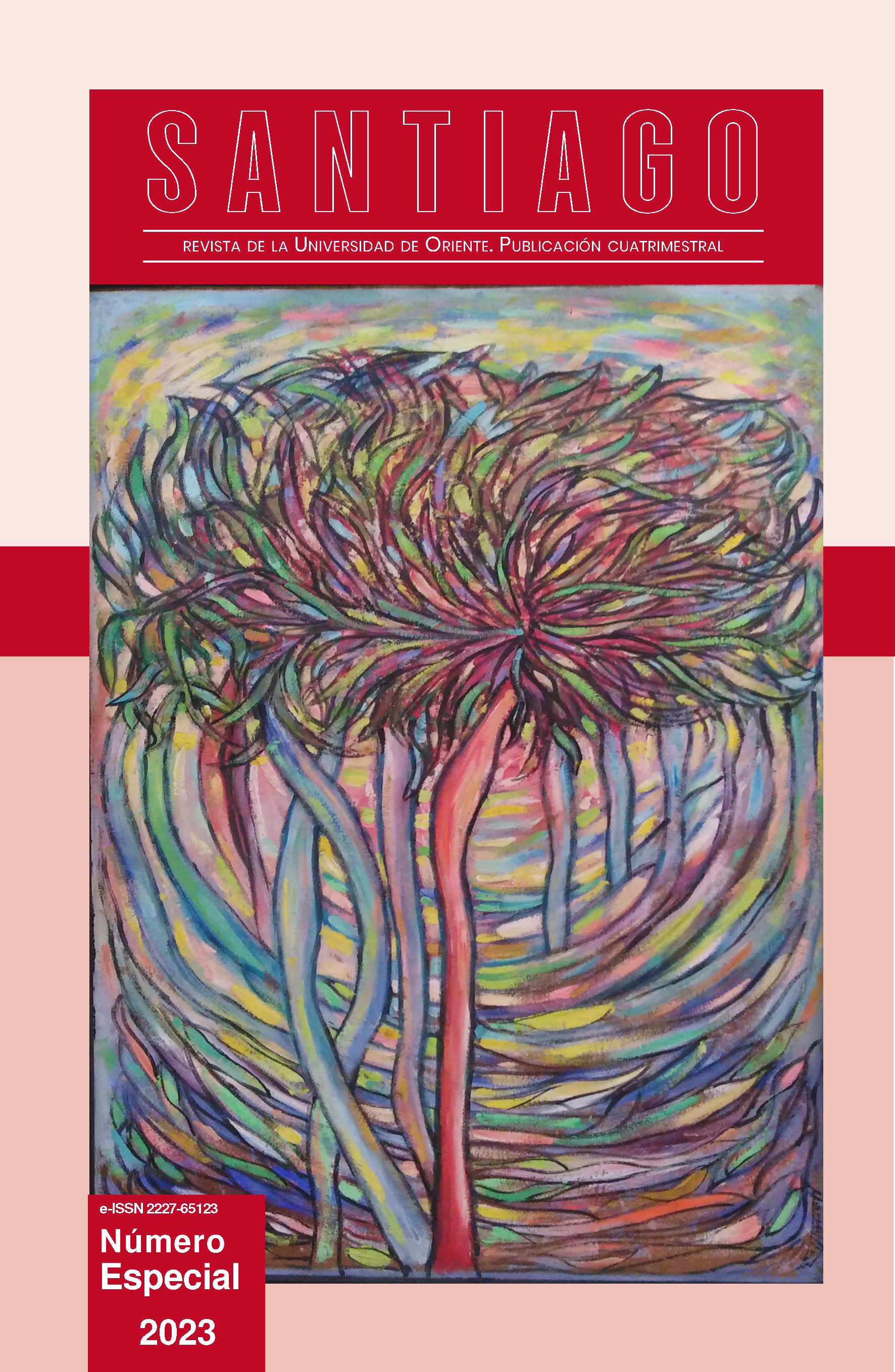Alterations associated with the use of orofacial piercing in adolescents at the Antonio Robert Ducass Polytechnic
Keywords:
adolescents, piercing, alterations.Abstract
A cross-sectional descriptive study was carried out with the
objective of identifying the most frequent orofacial alterations in adolescents
with piercings from the Antonio Robert Ducass Polytechnic.
During the study it was observed that the use of piercing was more frequent in the male sex (84.3%), with a predominance of the age group of 16 years (29.7%). The main cause that motivated them to place the piercing was fashion (55.7%). There was not much variation between the harmful habits, with 59.7% being smokers and 79.7% drinking alcoholic beverages on occasion. The most frequent location of these piercings was the region of the middle third of the face (56.9%), together with lingual piercings (83.4%), with a predominance of Labrette types (41.1%). The immediate manifestations were the most frequent with 63.4%, along with them local infections 52.3% and speech disorders with 15.4%.
References
Anbarlouei, M; Sarbakhsh, P; Dadashzadeh, H; Ghiasi, A; Ataieasl, M; Dorosti, A and Mohammadpoorasl, A. (2018). Cigarette and hookah smoking and their relationship with self-esteem and communication skills among high school students. Health Pro- motPerspect; 8(3), 230-236. doi: 10.15171/hpp.2018.31
Bajkin, B; Babic, I; Petrovic, B; Markovic, D. (2014). Substantial bone loss in the mandibular central incisors area as a complication of tongue piercing: a case report. Eur J PaediatrDent, 15(1), 75-7.
Clavería Clark RA, Ortiz Moncada C, Fouces Gutiérrez Y, Tabares Urdaneta RR, Muñoz Torres Y. (2009). ¡Cuidado con los piercings bucales! [artículo en línea]. MEDISAN; 13(3). http://bvs.sld.cu/revistas/san/vol13_3_09/san06309.htm
Colectivo de Autores. (2017). Programa Nacional de Atención Estomatológica a la Población. Editorial Ciencias Médicas.
Delgado, K. (2016). Alteraciones causadas por uso del piercing bucal. Revista Venezolana de Investigación Odontóloga IADR; 4 (1), 92-105.
Díaz, et al. (2018). Adolescencia y autoestima: su desarrollo desde las instituciones educativas. Revista Conrado; 14(64), 98-03.:https://www.researchgate.net/profile/Dayana-Diaz-Falcon/publication/328529437_Adolescencia_y_autoestima_su_desarrollo_desde_las_instituciones_educativas/links/5bd29b294585150b2b876faf/Adolescencia-y-autoestima-su-desarrollo-desde-las-instituciones-educativas.pdf
Flechas Duarte, Z, Guerrero Torres, M, Marin Romero, L y Porras Bueno, M. (2016). Prevalencia de piercing oral y lesiones bucodentales en adolescentes del colegio Humberto Gómez Nigrinis de Piedecuesta. Universidad Santo Tomás. [Trabajo de Grado de Universidad Santo Tomás, Bucaramanga División de Ciencias de la Salud Facultad de odontología].https://repository.usta.edu.co/handle/11634/9670
García, Ávila, I and Ramírez Martín, N. (2013). Los consumos estéticos y la salud juvenil: una aproximación para el debate médico-social. Medicentro Electrónica; 17(1), 34-36.
Solano, G.G., & Romero, K.E. (2015). Piercing lingual vs patología pulpar. Reporte de un caso y revisión bibliográfica. IntraMed Journal, 4.
González, Hernández M, Pacheco Domínguez A. (2011). Efectos negativos del uso de los piercings en la cavidad bucal. Revista Universidad Médica Pinareña; 7(1), pp. 71-82
Haces, M; Cardentey, J; Díaz, C D; Sacerio, M; Calero, Y. (2014). El uso del piercing en la cavidad bucal de adolescentes. Revista Ciencias Médicas 18(2), 267-274.
Hennequin, N, et al. (2016). The incidence of complications associated with lip and tongue piercing: a systematic review. Int J DentHyg, 14(1), 5-32.
Hinojosa, García L. et al. (2020). Autoestima y consumo de tabaco en adolescentes de secundaria. Sanus, 5(14), 1-10.
Ravelo, M; García, F; Hernández, A; Vázquez, C. (2019).Los piercing orales y sus complicaciones en estomatología. Medimay, 23(2). 124-136.
Lazarz, Bartyzel, K, et al. (2021). Local complications of lip and tongue piercing.Report of the cases.PrzeglLek, 70(9), 757-60.
Machena, L, Fernández, C. M. (2015). Complicaciones bucales de los piercings orales, RDOE, 11(1):37-8. http://www.redoe.com/ver.php?id=215
Méndez, Gallardo, M. G. (2021). Uso de Piercing como factor de riesgo asociado a trastornos temporomandibulares en adolescentes [tesis de Maestría, Universidad Alas Peruanas, Perú]. https://repositorio.uap.edu.pe/xmlui/bitstream/handle/20.500.12990/5268/Tesis_Trastornos_Temporomandibulares.pdf?sequence=1
Nagrath, D; Mathur, R; Zodpey, P. (2019). Tobacco use in adolescence: Influence of socio-demographic and socioeconomic factors. Preventive Medicine Reports, 14,1-4; https://doi.org/10.1016/j.pmedr.2019.100832
Organización Mundial de la Salud (OMS). (2018). Tabaco. OMS. https://www.who.int/es/news-room/fact-sheets/detail/tobacco
Ortiz, L. M. C, et al (2018). Factores psicosociales asociados al consumo de drogas en estudiantes de dos universidades de América Latina. Revista Salud Pública, 22(1), 41-52, https://doi.org/10.31052/1853.1180.v22. n1.18655
Quintana Díaz, J., Villareal Corvo, N., Quintana Giralt, M., & Rodríguez Reyes, D. (2018). Complicaciones y efectos negativos asociados al uso de los piercings en la región maxilofacial. Medimay, 25(3), 190-200.
Rivera, Fortuna A. (2021). Alteraciones asociadas al uso de piercing orofaciales en adolescentes del preuniversitario José Miguel Bañuls. [Tesis de Licenciatura en Estomatología, Universidad de Ciencias Médicas, Santiago de Cuba]
Romero, Urréa H. E, et al. (2020). Uso de los tatuajes y piercings como factores influyentes en la personalidad. RESBIC, 4 (2), 53-65.
Santana González, Y., Torres Rodríguez, O., Rodríguez Martínez, Y., Silva Albear, Y., & Oris Martínez, L. (2022). Acciones de atención psicológica durante la covid-19 a través del chat “Santiago se Levanta”. Revista Conhecimento Online, 1, 189–212. https://doi.org/10.25112/rco.v1.2737
Sayé, Ll. (2020). Controles de salud en la adolescencia. Pediatr Integral, 9(1), 29-36.
Schoeps, K, et al. (2019). Competencias emocionales y autoestima en la adolescencia: impacto sobre el ajuste psicológico. Revista de Psicología Clínica con Niños y Adolescentes, 6(1), 51.56. https://doi:10.21134/rpc- na.2019.06.1.7
Simoes, A, et al. (2014). Prevalencia de complicaos associada a colocao de piercingsorais. Revista Portuguesa de Estomatología MedDentCirgMaxilofa, 55(4), 243-9.
Trujillo, Alemán R, Hernández, Acosta. M. (2014). Queloide provocado por una perforación en la oreja, en una niña haitiana. Medisur, 12(1).
Urbiola,Alís I, Viñals Iglesia H. (2005). Algunas consideraciones acerca de los piercing orales. Odontoestomatol, 21(5).
Villalobos Montero A, Barzuna Ulloa M, Barzuna Pacheco M. (2018). Repercusiones en la cavidad oral por la utilización de piercing. Reporte de un caso. Odontol Sanmarquina [Internet]. 21 de marzo de 2018 [citado 9 de marzo de 2023];21(1):57-61.
Vozza I, Fusco F, Corridore D, Ottolenghi L. (2015).Awareness of complications and maintenance mode of oral piercing in a group of adolescents and young Italian adults with intraoral piercing. Med Oral Patol Oral Cir Bucal. 2015 Jul 1;20(4), 413-8. doi: 10.4317/medoral.20487
Downloads
Published
Issue
Section
License
Copyright (c) 2023 Virginia Cano-Reyes, Alina Arocha-Arzuaga, Alba Veliz-Pérez, Tania María Cañete-Revé

This work is licensed under a Creative Commons Attribution-NonCommercial-NoDerivatives 4.0 International License.
CC Reconocimiento-NoComercial-SinObrasDerivadas 4.0


.jpg)

_de_logo.jpg)












